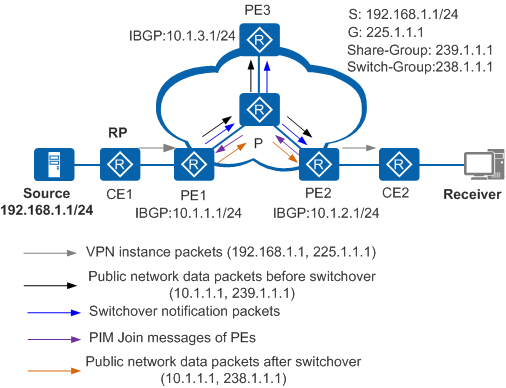Switch-MDT Switchover
When multicast data packets of a VPN instance are transmitted along a Share-MDT, all PE devices bound to the VPN instance will receive these packets, regardless of whether receivers exist at the sites connected to the PE devices. When the rate of VPN multicast data packets is high, a flood of multicast data may occur on the public network. This consumes excessive network bandwidth and increases resource consumption on PE devices.
An optimized solution Switch-MDT was developed to solve this problem. This section describes the Switch-MDT implementation under an assumption that a Share-MDT has been established.
Switchover from Share-MDT to Switch-MDT
You can configure a Switch-MDT switchover policy to specify that a Switch-MDT switchover is triggered when either or both of the following requirements are met:
VPN multicast data packets are permitted by advanced ACL rules. If you are aware that the rate of packets sent from a multicast source or to a multicast group is high, you can specify a group address or source address range for Switch-MDT forwarding in an advanced ACL rule.
The rate of VPN multicast data packets stays above the switchover threshold for a specified period of time.
In some cases, the rate of VPN multicast data packets fluctuates above and below the switchover threshold. To prevent frequent switchovers between the Share-MDT and Switch-MDT, the system does not trigger a switchover immediately after detecting that multicast data traffic rate is lower than the switchover threshold. Instead, the system starts the Switch-Delay timer and continues detecting the traffic rate before timer expires. If the rate remains higher than the switchover threshold when the timer expires, the transmission path of multicast data packets is switched to the Switch-MDT. If the rate falls below the switchover threshold, packets are still forwarded along the Share-MDT.
- The source PE is assigned an unused Switch-Group address from the Switch-Group-Pool. It periodically sends switchover notification packets to downstream PE devices along the Share-MDT. A switchover notification packet carries the VPN multicast source address, VPN multicast group address, and Switch-Group address.
- When receiving a switchover notification packet, downstream PE devices check whether there are receivers at the connected sites. If receivers exist, they send a PIM Join message to join the Switch-MDT with the Switch-Group address as the group address and the source PE as the root. If no receiver exists, the PE devices cache the switchover notification packet and join the Switch-MDT when receivers appear.
The source PE sends an MDT switchover packet and waits for the timeout period of the Switch-Delay timer. If the switchover conditions are still met when the Switch-Delay timer expires, the source PE starts to encapsulate VPN multicast data using the Switch-Group address. Multicast data packets are then transmitted along the Switch-MDT.
The Switch-Delay timer leaves certain time for downstream PE devices to join the Switch-MDT, minimizing data loss during a switchover. The Switch-Delay timer value is configurable.
- After the Switch-MDT switchover is complete, the source PE still periodically sends switchover notification packets, allowing new PE devices to join the Switch-MDT. When no receiver exists at the sites connected to the downstream PE devices, the PE devices can leave the Switch-MDT.
Figure 1 shows a Share-MDT to Switch-MDT switchover process.
In Figure 1, before the Switch-MDT is configured, PE1 encapsulates a VPN multicast data packet (192.168.1.1, 225.1.1.1) into a public network data packet (10.1.1.1, 239.1.1.1) and sends the packet along the Share-MDT. PE2 and PE3 receive the packet and decapsulate it. PE3 drops the packet because there are no receivers at the site connected to it. The site connected to PE2 has receivers, so PE2 sends the decapsulated VPN multicast data packet to CE2.
After the Switch-MDT switchover condition and Switch-Group-Pool are configured on PE1, PE1 monitors packets sent from the multicast source. When the switchover conditions are met, PE1 selects group address 238.1.1.1 from the Switch-Group-Pool and periodically sends switchover notification packets to other PE devices along the Share-MDT.
The site connected to PE2 has receivers, so PE2 sends a PIM Join message to join group 238.1.1.1 and establishes a Switch-MDT. The site connected to PE3 has no receivers, so PE3 does not join the Switch-MDT. Only PE2 will receive all the public data packets (10.1.1.1, 238.1.1.1) encapsulated from VPN multicast data packets (192.168.1.1, 225.1.1.1).

After a switchover from the Share-MDT to the Switch-MDT, only multicast data packets are transmitted along the Switch-MDT. Multicast protocol packets are still transmitted along the Share-MDT.
Switchback from the Switch-MDT to the Share-MDT
If the switchover conditions are no longer met when VPN multicast data packets are transmitted along the Switch-MDT, PE1 switches multicast data packets back to the Share-MDT. The switchback is performed in either of the following circumstances:
The rate of VPN multicast data packets stays below the switchover threshold during the timeout period of the Switch-Holddown timer.
In some cases, the rate of VPN multicast data packets fluctuates above and below the switchover threshold. To prevent frequent switchover between the Switch-MDT and Share-MDT, the system does not perform a switchover immediately upon detecting that the forwarding rate is lower than the switchover threshold. Instead, the system starts the Switch-Holddown timer and continues detecting the data forwarding rate before the timer expires. If the rate remains lower than the switchover threshold when the Switch-Holddown timer expires, the transmission path of data packets is switched to the Share-MDT. If the rate becomes higher than the switchover threshold, the packets are still forwarded along the Switch-MDT. The Switch-Holddown timer value is configurable.
The Switch-Group-Pool is changed, and the Switch-Group address used for encapsulating VPN multicast data packets does not exist in the new Switch-Group-Pool.
The advanced ACL rules controlling the switchover to the Switch-MDT are changed, and the new ACL rules deny VPN multicast data packets.
